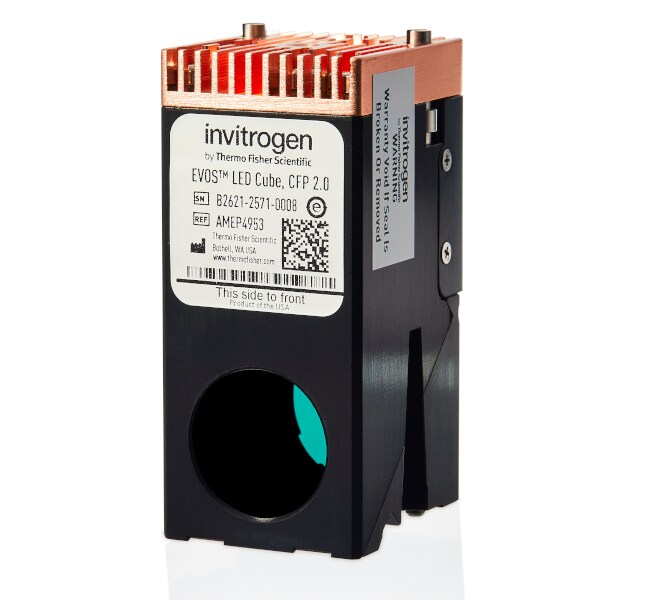Our second-generation EVOS LED light cubes provide superior illumination uniformity across the field of view, resulting in exceptional tile-stitch image quality. At the same time, optimized spectral fidelity across channels significantly improves data quality by minimizing undesired bleed-through. Like the original design, they combine condensing optics and hard-coated filters into one remarkable light engine that delivers digitally controlled fluorophore excitation.
These LED light cubes are backwards compatible with older EVOS and Countess systems and can be used with first-generation light cubes. Like the original light cubes, these LED cubes are user-changeable and automatically recognized by the instrument. The EVOS Light Cube, CFP 2.0, is ideal for use with CellLight CFP, ECFP, Evans Blue, Lucifer Yellow, and other fluorophores with excitation and emission maxima near 445 and 510 nm.
EVOS LED light cubes you these important advantages:
• Uniform illumination across the entire field of view for superb image quality
• Optimized spectral compatibility to maximize true signal detection, while minimizing bleed-through for the best possible data quality
• A short light path that affords superior detection of fluorescent signals
• Stable illumination intensity over 50,000 hours that helps experimental reproducibility
Efficient light engines Our second-generation light cube design dramatically improves on the original. A larger aperture increases illumination uniformity, which affords superb tile-stitched image quality and consistency. In addition, new LED light and filter combinations maximize the signal-to-background ratio so critical for dim samples, improving data quality irrespective of signal strength for both EVOS and Countess systems. By placing the LED light cube as close as possible to the objective turret, the number of optical elements in the light path is minimized. High-intensity illumination over a short light path increases the efficiency of fluorophore excitation, providing better detection of weak fluorescent signals.
Hard-coated filter sets for higher transmission efficiencies Hard-coated filters are more expensive but have sharper edges and significantly higher transmission efficiencies that typically result in >25% higher light transmission compared to soft-coated filters. LED bulbs and filters optimized to maximize the signal from target fluorophores, while minimizing that from other dyes (i.e., bleed-through), will help you obtain brighter fluorescence, higher transmission efficiencies and ability to detect faint fluorescence signals, and better signal-to-noise ratios. These factors raise both image and data qualities.
Continuous light intensity Mercury arc lamps can decrease in intensity by 50% in the first 100 hours of operation—plus, images acquired in different sessions cannot be quantitatively compared using mercury illumination without complicated calibrations. EVOS cubes retain continuous light cube intensity that affords consistent illumination from day to day and experiment to experiment and help you to directly compare quantitative results from images acquired on different days. Each light cube contains a precisely matched set of optical components to optimize the position, evenness, and intensity of the light beam. These digitally controlled light sources make it easy to adjust light intensity, exposure time, and camera gain that can reduce phototoxicity and photobleaching.
Less expensive to own and maintain The LED bulbs on the EVOS systems are rated for >50,000 hours, compared to 300 hours for a typical mercury bulb and 1,500 hours for a metal halide bulb. This translates to savings in the overall upkeep of your instrument.
To select the light cube best suited for your experiments, visit the
Light Cube selection guide.
Explore the entire EVOS line of imaging systems and accessories ›For Research Use Only. Not for use in diagnostic procedures.
